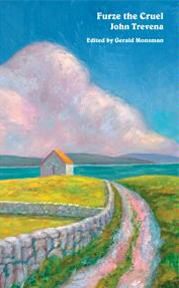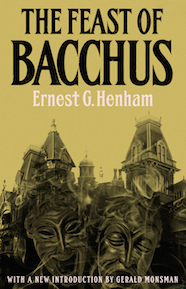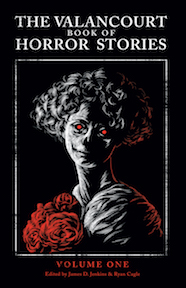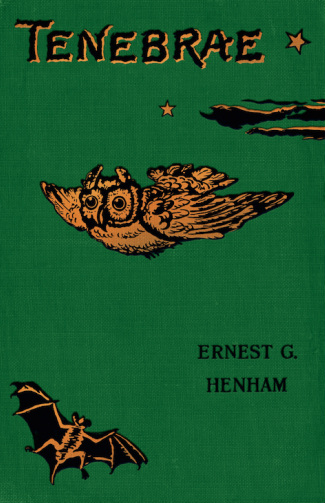
Tenebrae (1898)
Ernest G. Henham
The narrator of Tenebrae inhabits a decaying, desolate mansion in the remote and wild countryside with his younger brother and their mad old uncle, driven insane by abuse of opium and alcohol. This nameless narrator is a morbid young man who passes most of his time in a room painted all black, poring over arcane manuscripts dealing with the mysteries of death, while sipping garishly coloured liquors brewed by his uncle or cups of coffee flavoured with arsenic.
When he falls in love with a neighbour, he looks forward to marrying her and trading his life of despondency for one of joy. Perhaps unsurprisingly, though, she finds him rather unpleasant company and instead falls in love with his brother. Driven to murderous jealousy, he resolves upon a brutal crime. But after the consummation of his terrible act, he finds himself haunted by a huge, monstrous spider. Is it a delusion brought on by incipient madness? the reincarnated soul of his murdered victim, returned for vengeance? or does it foretell a fate even more horrifying than can be possibly imagined?
Published in 1898, at the end of a decade in which English writers explored the literary possibilities of the Gothic with such characters as Dorian Gray, Dr Jekyll and Mr Hyde, Dracula, and The Beetle, Ernest G. Henham's weird horror novel Tenebrae is reminiscent of the works of Poe. Perhaps unequalled in its extreme darkness and gloom, and yet at times grimly, though possibly unintentionally, hilarious, Tenebrae remains one of the strangest productions of this fertile literary period. This newly typeset edition includes the unabridged text of the first edition, as well as an introduction and notes by Gerald Monsman, the foremost scholar of Henham (1870-1946), who later published under the name John Trevena. Also featured is a reproduction of the cover of the incredibly scarce first edition.
Ernest G. Henham
The narrator of Tenebrae inhabits a decaying, desolate mansion in the remote and wild countryside with his younger brother and their mad old uncle, driven insane by abuse of opium and alcohol. This nameless narrator is a morbid young man who passes most of his time in a room painted all black, poring over arcane manuscripts dealing with the mysteries of death, while sipping garishly coloured liquors brewed by his uncle or cups of coffee flavoured with arsenic.
When he falls in love with a neighbour, he looks forward to marrying her and trading his life of despondency for one of joy. Perhaps unsurprisingly, though, she finds him rather unpleasant company and instead falls in love with his brother. Driven to murderous jealousy, he resolves upon a brutal crime. But after the consummation of his terrible act, he finds himself haunted by a huge, monstrous spider. Is it a delusion brought on by incipient madness? the reincarnated soul of his murdered victim, returned for vengeance? or does it foretell a fate even more horrifying than can be possibly imagined?
Published in 1898, at the end of a decade in which English writers explored the literary possibilities of the Gothic with such characters as Dorian Gray, Dr Jekyll and Mr Hyde, Dracula, and The Beetle, Ernest G. Henham's weird horror novel Tenebrae is reminiscent of the works of Poe. Perhaps unequalled in its extreme darkness and gloom, and yet at times grimly, though possibly unintentionally, hilarious, Tenebrae remains one of the strangest productions of this fertile literary period. This newly typeset edition includes the unabridged text of the first edition, as well as an introduction and notes by Gerald Monsman, the foremost scholar of Henham (1870-1946), who later published under the name John Trevena. Also featured is a reproduction of the cover of the incredibly scarce first edition.
|
BOOK DETAILS
Trade paper ISBN-13: 978-1934555293 List Price: $17.99 U.S. Pages: 228 Published: 2012 |
|
ALSO AVAILABLE THROUGH ONLINE RETAILERS
|
EBOOK
Kindle US |
MORE TITLES BY THIS AUTHOR
AUTHOR BIOGRAPHY
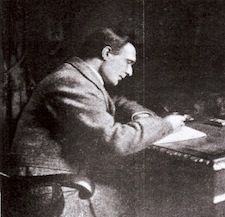
Ernest George Henham (“John Trevena”) was born in England in 1870, and as a young man travelled to America and Canada and lived for some time in the Canadian Northwest. His experiences in Canada, including his memories of the Riel Rebellion in the 1880s, provided the inspiration for some of his early works, which were published under his own name. As Ernest G. Henham, he published Menotah: A Tale of the Riel Rebellion (1897), which ran into at least three editions, God, Man & The Devil: A Novel(1897); the weird Gothic horror novel Tenebrae (1898); Bonanza: A Story of the Outside (1901); Scud: The Story of a Feud (1902); The Plowshare and the Sword: A Tale of Old Quebec (1903); ‘Krum’: A Study of Consciousness (1904); and The Feast of Bacchus: A Study in Dramatic Atmosphere (1907).
Suffering from ill health, he moved to Dartmoor around this time. In the words of a contemporary, “It is one of the strangest facts in literary history that a man, who had defined his place as a writer of fiction with nine novels or so, published under his own name, should have seen fit, after the Boer War, to begin his career afresh and write a long series of commercially unsuccessful novels under a pseudonym.” However, this was what Henham did, publishing A Pixy in Petticoats anonymously in 1906 before adopting the pseudonym John Trevena in 1907 for publication of Furze the Cruel. Furze was the first in a trilogy of novels focusing upon Dartmoor life, followed by Heather (1908) and Granite (1909). He continued to write prolifically, achieving widespread critical acclaim but little commercial success; his notable works include Bracken (1910), the story collection Written in the Rain (1910), Wintering Hay (1912), which the Los Angeles Times ranked with the works of Turgenev and Dostoevsky, Sleeping Waters (1913), and Moyle Church-Town (1915). Trevena’s life has become so shrouded in obscurity that as of the time of this printing even his date of death is not known, but he is believed to have died around 1946. Until Valancourt Books’ edition of Furze the Cruel in 2010, all his works were out of print, despite the near-universal critical consensus during his lifetime that his works would live on among the classics of English fiction.
Suffering from ill health, he moved to Dartmoor around this time. In the words of a contemporary, “It is one of the strangest facts in literary history that a man, who had defined his place as a writer of fiction with nine novels or so, published under his own name, should have seen fit, after the Boer War, to begin his career afresh and write a long series of commercially unsuccessful novels under a pseudonym.” However, this was what Henham did, publishing A Pixy in Petticoats anonymously in 1906 before adopting the pseudonym John Trevena in 1907 for publication of Furze the Cruel. Furze was the first in a trilogy of novels focusing upon Dartmoor life, followed by Heather (1908) and Granite (1909). He continued to write prolifically, achieving widespread critical acclaim but little commercial success; his notable works include Bracken (1910), the story collection Written in the Rain (1910), Wintering Hay (1912), which the Los Angeles Times ranked with the works of Turgenev and Dostoevsky, Sleeping Waters (1913), and Moyle Church-Town (1915). Trevena’s life has become so shrouded in obscurity that as of the time of this printing even his date of death is not known, but he is believed to have died around 1946. Until Valancourt Books’ edition of Furze the Cruel in 2010, all his works were out of print, despite the near-universal critical consensus during his lifetime that his works would live on among the classics of English fiction.

